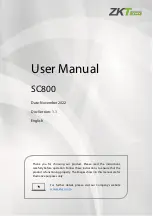
68
VAV-SVP01A-EN
Sequence of Operations
Occupancy Modes
VAV VV550 Controllers have four valid occupancy modes: Occupied, Unoccupied, Occupied
standby, and Occupied Bypass.
Occupied Mode
Occupied mode is the normal (default) operating mode for occupied spaces or daytime operation.
When the controller is in the occupied mode, it uses occupied setpoints and runs in:
•
Occupied temperature control;
•
Ventilation flow control or space temperature control;
•
Flow tracking control.
Unoccupied Mode
Unoccupied mode (also known as night setback) is the normal operating mode for unoccupied
spaces or nighttime operation. Unoccupied setpoints enable or disable occupied space
temperature control.
When the controller is in the unoccupied mode and configured for space temperature control, the
controller attempts to keep the space temperature between the active unoccupied heating setpoint
and the active unoccupied cooling setpoint. When the controller is in the unoccupied mode and
configured for ventilation flow control, it will not run in unoccupied mode, the air valve is closed,
and local heat is disabled.
A flow tracking controller runs the same as when it is occupied. When the controller is in the
unoccupied mode and configured for flow tracking control, it runs the same as it does in occupied
mode.
Occupied Standby Mode
Occupied standby mode is used to reduce the heating and cooling demands during the occupied
hours when the space is unoccupied. It can be activated for a classroom currently not in use.
The controller can be placed in the occupied standby mode when a communicated occupancy
mode request (from a communicated occupancy override, occupancy schedule, or occupancy
sensor) is combined with an occupancy request from the local (hardwired) occupancy binary input.
Once in occupied standby mode, the controller uses the occupied standby cooling and heating
setpoints, which typically cover a wider range than the occupied setpoints. The wider range
reduces the demand for heating and cooling in the space.
When the communicated occupancy mode request is unoccupied, the occupancy binary input
signal (if present) does not affect the controller occupancy mode. When the communicated
occupancy mode request (communicated occupancy override not valid, communicated occupancy
schedule occupied, or communicated occupancy sensor not valid) is occupied, the controller uses
the local occupancy binary input to switch between the occupied and occupied standby modes.
When the controller is in the occupied standby mode, it uses occupied standby setpoints and runs
in:
•
Occupied temperature control;
•
Ventilation flow control or space temperature control;
•
Flow tracking control.
Occupied Bypass Mode
Occupied bypass mode is used for timed overrides. For example, if the controller is in unoccupied
mode or occupied standby mode, pressing the zone sensor ON button places the controller in
occupied bypass mode for 120 minutes (default configured occupied bypass time) or until
someone presses the zone sensor CANCEL button. The controller can be placed in occupied bypass
Содержание VAV VV550 LonTalk
Страница 1: ...May 2010 VAV SVP01A EN Installation Operation Programming VAV VV550 LonTalk Controller...
Страница 17: ...VAV SVP01A EN 17 VAV Start Up Check Out Procedure Figure 2 VV550 single duct control diagram...
Страница 18: ...18 VAV SVP01A EN VAV Start Up Check Out Procedure Figure 3 VV550 fan powered control diagram...
Страница 107: ...VAV SVP01A EN 107 Troubleshooting Figure 59 VV550 single duct control diagram...
Страница 108: ...108 VAV SVP01A EN Troubleshooting Figure 60 VV550 fan powered control diagram...
Страница 110: ...110 VAV SVP01A EN Troubleshooting Figure 62 Single duct with three phase voltage electric heat...
Страница 112: ...112 VAV SVP01A EN Troubleshooting Figure 64 SCR PSC fan powered with three phase voltage electric heat...
Страница 114: ...114 VAV SVP01A EN Troubleshooting Figure 66 ECM fan powered with three phase voltage electric heat...
Страница 115: ......
















































